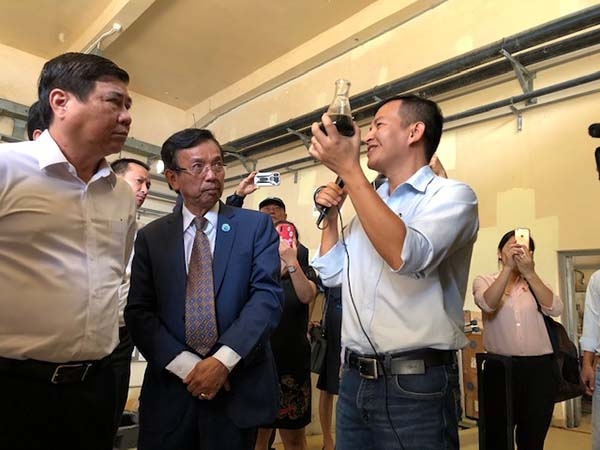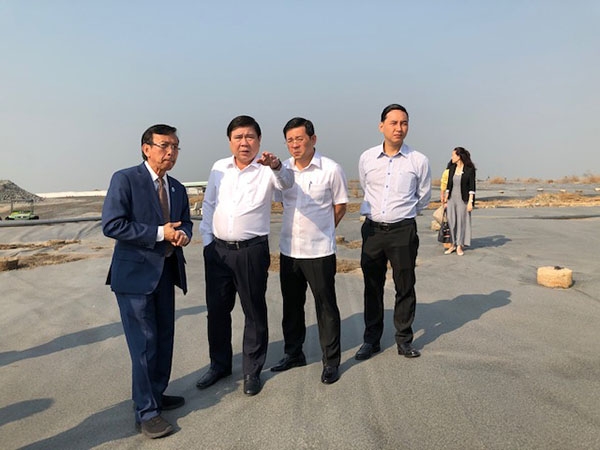Upgrading waste treatment tech urgent requirement for Ho Chi Minh City
 |
| Nguyen Thanh Phong, Chairman of Ho Chi Minh City People's Committee, visited Da Phuoc Solid Waste Treatment Complex |
VWS is ready to invest
At the meeting, David Duong, president cum CEO of Vietnam Waste Solutions (VWS), shared about the project to convert waste treatment technology at the 12,83-hectare Da Phuoc complex with a daily treatment capacity of 3,000 tonnes of waste.
The project aims to convert garbage into electricity and by-products such as liquid fertiliser, compressed natural gas (CNG), and compost, which will help reduce landfill waste as well as carbon and greenhouse gas emissions. Once put into operation, the project will treat 1,000 tonnes of waste to generate 20MWh of electricity, 7MWh of biogas power, and 10,200 kilogrammes of CNG per day. The project also provides 410 tonnes of liquid fertiliser, 410 tonnes of compost per day and soil improvement products up to 900 tonnes per day.
Thanks to the new technology, VWS can develop a self-contained process from waste receipt to handling to provide eco-friendly byproducts and reduce landfill waste. The self-contained system incorporates a biological filter to prevent unpleasant smells.
The project has a total investment of more than $430 million. Waste will be treated at a price of $33.6 per tonne. It is estimated to take nearly 23 years to get return on investment.
According to Nguyen Toan Thang, director of the Ho Chi Minh City Department of Natural Resources and Environment, this project has the largest waste treatment capacity in the city in terms of burning and supplying by-products. Through the evaluation process, the treatment technologies are advanced and modern. Therefore, the appraisal working group has officially submitted the project to the Ho Chi Minh City leaders for consideration and approval so that VWS will soon implement the next steps.
 |
| Phong urged the relevant departments and agencies to accelerate project approval |
The city to accelerate the project
After the survey, Phong said, “After exploring the technology at the complex, I think that David Duong and his team of experts have shown their determination to invest in the project and contribute to solving the city's environmental and waste treatment problems. Their remarkable efforts also show the enthusiasm of overseas Vietnamese investors to return to their homeland.”
Phong added, “VWS has adopted the burial technology at the complex, which suits the city’s conditions. VWS also uses modern technology for sewage and wastewater treatment plants. In particular, wastewater with many impurities can be converted into water for immediate use."
“Furthermore, VWS not only creates employment for locals but also carries out many corporate social responsibility activities. Therefore, I highly appreciate the company’s efforts in the past years,” he emphasised.
Ho Chi Minh City aims to increase waste-to-energy efficiency to 50 per cent by 2020 and 75 per cent by 2025. Thus, landfill waste will be reduced to around 25 per cent by 2025. The city is attracting waste-to-energy investment projects in line with the targets. VWS plays an important role in this plan.
Ho Chi Minh City is facing growing population pressure and economic development, which requires the city to apply new technologies in waste treatment. Therefore, it is necessary to convert old technology to modern alternatives. Another thing to keep in mind is when choosing a technology, one must understand and be knowledgeable about the city’s waste composition so it would not affect the environment badly.
Regarding VWS' proposal for technology conversion, the municipal chairman ordered the Department of Natural Resources and Environment to form a council to evaluate new technology. He also invited David Duong to present the project to the council for approval.
“I will also work with the vice chairman in charge to discuss other issues and solve difficulties for VWS to carry out the project soon. The relevant departments and agencies should find solutions to implement the projects soon. Among them, the Department of Natural Resources and Environment should take prompt action to accelerate the approval for this project,” he stated.
What the stars mean:
★ Poor ★ ★ Promising ★★★ Good ★★★★ Very good ★★★★★ Exceptional
Related Contents
Latest News
More News
- Businesses ramp up production as year-end orders surge (December 30, 2025 | 10:05)
- Vietjet chairwoman awarded Labour Hero title (December 29, 2025 | 13:06)
- How to unlock ESG value through green innovation (December 29, 2025 | 10:03)
- AI reshapes media and advertising industry (December 29, 2025 | 08:33)
- FPT and GELEX sign deal to develop blockchain tech for global markets (December 29, 2025 | 08:29)
- Vietnam’s GDP forecast to grow by 9 per cent in 2026 (December 29, 2025 | 08:29)
- Women entrepreneurs are key to Vietnam’s economic growth (December 29, 2025 | 08:00)
- Vietnam's top 500 value-creating enterprises announced (December 27, 2025 | 08:00)
- The PAN Group shaping a better future with ESG strategy (December 26, 2025 | 09:00)
- Masan Consumer officially lists on HSX, marking the next phase of value creation (December 25, 2025 | 13:20)

 Tag:
Tag:





















 Mobile Version
Mobile Version